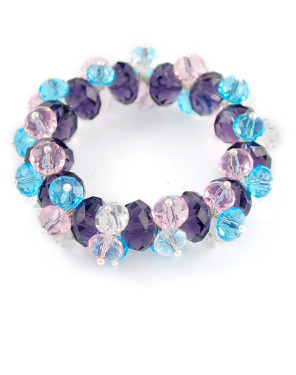Synthetic crystal and glass products
Hacci Fabric,Rayon Blend Fabric,Polyester Blend Fabric,Blend Knit Fabrics Shaoxing Ruby Textile Co., Ltd , https://www.sxrubytex.com Common natural crystal substitutes on the market mainly include synthetic crystals and glass products. The identification methods are respectively introduced as follows:
Common natural crystal substitutes on the market mainly include synthetic crystals and glass products. The identification methods are respectively introduced as follows:
The composition and structure of synthetic crystals are exactly the same as those of natural crystals, especially when the interior of the crystal is very clean and you cannot see any features. Even if the laboratory identification is difficult, you must rely on large instruments. In this case, it is difficult to distinguish between natural and synthetic crystals only by portable instruments such as the naked eye and the tenfold magnifying glass. However, there is also a method that is not very easy to use. That is, the crystal to be tested is placed at room temperature and its temperature is stabilized, and then the hand feels coldness. In general, natural crystals are cooler, and synthetic crystals or glass have a warm feeling. However, this method is greatly affected by the weather and the environment, not applicable in winter. And because individuals have different perceptions of temperature, they are only an aid to identification.
However, in most natural crystals, there are more or less inclusions, which are often referred to as cotton, alfalfa, clouds, mineral inclusions, etc., to form green ghosts, colored hair crystals and other varieties, one is full of vitality. Synthetic crystals are relatively clean, but sometimes there are some features.
One of the following features can be identified as synthetic crystal:
1) There will be a layer of gray on the glass desktop that will not be rubbed for a while. This phenomenon must have been seen by everyone. If you see something like "dust on the desktop" inside the crystal, it means that there are many very tiny gray or white dots along the crystal or several parallel planes, and the rest of the crystal is very clean. That's basically a synthetic crystal.
2) Synthetic crystals sometimes have very fine hollow tubular inclusions. These empty tubes are also basically parallel, sometimes leading to the surface, or they may be big and small, like nails. This is also only found in synthetic crystals, which may be some flux residue during synthesis.
3) Natural crystals are basically green or extremely rare. Like green ghosts, green hair crystals and other varieties, the inclusions inside are green, but the crystal itself is colorless and transparent. Therefore, a large number of green and transparent crystals appear on the market, the colors are basically processed, and most of them are synthetic crystals.
Very cheap imitations can be of various colors, and sometimes they can be made translucent and relatively easy to identify. The following features can be seen as glass:
1) Many books teach people to distinguish the crystal ball and the glass ball with the method of seeing the ghost of the hair. It is to put a hair under it and look through the ball to the hair. If the hair becomes two, it is the crystal (natural or synthetic). Still one is glass. However, this method has some limitations: The ball cannot be too small. If it is a ball on a string, it will not work. And when watching, pay attention to turning the crystal ball to observe. Not all directions will have a ghost image. I am not too cold about the crystal ball, so I don't think much about it, but here I would like to remind my friends who want to buy the crystal ball: Those who are not small, the interior is very clean, and the price is not too expensive, we must pay attention to the “crystal ballâ€. It may be synthetic crystal or glass. When purchasing it, it must ask for a certificate issued by a nationally recognized professional institution.
2) Bubbles can only appear in glass, but they can vary in size. However, in natural chalcedony, there are sometimes spherical inclusions. I have seen some of them, and it is easy to think that bubbles are not noticeable. The difference is that the surface of the bubble is bright and reflective, and the surface gloss of the inclusion body is much darker. This requires experience. It can be grasped by looking at it.
3) Glass products are generally cast or blow molded, while crystals are ground and polished. Therefore, beads like water are sometimes not round enough, and there are some remaining planes or gaps in some places; while the facet sizes of faceted crystals may be inconsistent. These “cockroaches†are actually the labels of crystals, because the glass may only have indentations at the time of casting. (Seen in many plastic products) or spirals when blown.